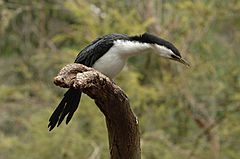Cormorant facts for kids
Quick facts for kids Cormorants and shags |
|
|---|---|
 |
|
| Little pied cormorant Phalacrocorax melanoleucos |
|
| Scientific classification | |
| Kingdom: | |
| Phylum: | |
| Class: | |
| Subclass: | |
| Infraclass: |
Neoaves
|
| Order: | |
| Suborder: | |
| Family: |
Phalacrocoracidae
Reichenbach, 1850
|
| Genus: |
Phalacrocorax
|
Cormorants are a group of seabirds that belong to a special family. There are around 40 different species of cormorants found around the world. In some places, people also call them shags.
Contents
What Do Cormorants Look Like?
Cormorants come in different sizes. The smallest ones are about 45 cm (18 in) long and weigh 340 g (12 oz). The largest can be 100 cm (40 in) long and weigh up to 5 kg (11 lbs).
Most cormorants, especially those in the northern hemisphere, have mostly dark feathers. However, some species in the Southern Hemisphere are black and white. A few cormorant species are very colorful.
Many cormorants have brightly colored skin on their faces. This skin can be blue, orange, red, or yellow. These colors usually become even brighter during their breeding season.
A cormorant's bill is long, thin, and has a sharp hook at the end. Their feet are special too, with webbing between all four toes. This helps them swim very well. Cormorants can dive underwater for up to 4 minutes while they search for food.
Where Do Cormorants Live?
Cormorants build their nests and raise their young on rocky headlands and islands. They also live near inland lakes, marshes, and reservoirs.
During the winter, these birds spend their time along coasts, in estuaries, and on rivers, lakes, and reservoirs. They can be found in many different water environments.
Related Cormorant Species
Images for kids
-
Cormorant sculpture by Brian Fell on the Stone Jetty, Morecambe
See also
 In Spanish: Cormoranes para niños
In Spanish: Cormoranes para niños













